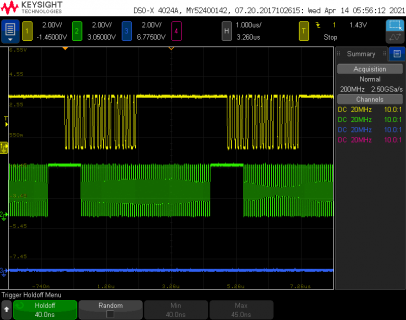What's the fastest way to send 6 bytes over SPI? I see DmaSpi, SPIFIFO, and some other libs.
I am using a Teensy 3.2. My application is transmit only, always 6 bytes, and no other devices/libs will be using SPI. No chip selects needed. No completion callback needed. Transmissions are on a fixed timer, so the tx fifo is guaranteed to be empty. I do need to use the alternate SCK pin, though.
I want to do this inside a 5us interval timer, if possible.
I am using a Teensy 3.2. My application is transmit only, always 6 bytes, and no other devices/libs will be using SPI. No chip selects needed. No completion callback needed. Transmissions are on a fixed timer, so the tx fifo is guaranteed to be empty. I do need to use the alternate SCK pin, though.
I want to do this inside a 5us interval timer, if possible.


